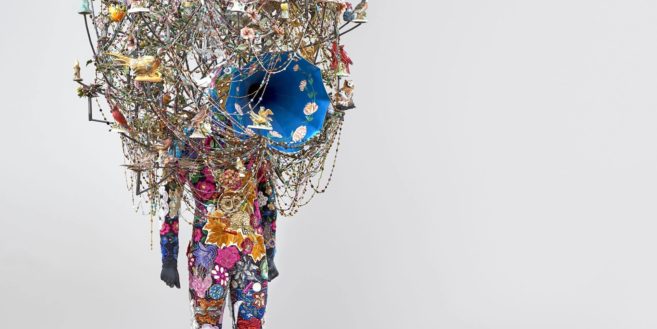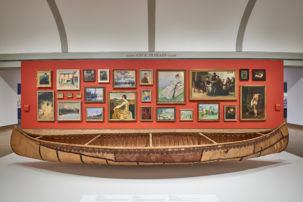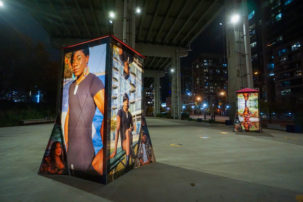There’s an ingenuity to bookending a parachuted-in art summit between two pre-existing art staples in a city: it initiates the unfamiliar via association, it takes on more than one event could handle on its own, and it interacts within preexisting infrastructure of the urban sphere.
These are all things that the 10th annual Creative Time Summit in Toronto did this past weekend. Usually the summit has taken place in New York, home base to Creative Time and its public art programs. But in Toronto, taking place between the Power Plant’s seasonal opening party and Nuit Blanche, the summit added much-needed critical content and context to the Nuit Blanche festival weekend.
Co-produced by the Power Plant and in collaboration with the Art Gallery of Ontario, the two-day summit culminated in an installation at Nathan Phillips Square, curated by Creative Time’s Nato Thompson, titled Monument to the Century of Revolutions. (The City of Toronto commissioned Thompson to curate the latter as part of Nuit Blanche.)
As Creative Time’s artistic director, Thompson explained that the Creative Time Summit doesn’t always have the privilege of collaborating with an established event such as Nuit Blanche, but in this case, “it really helped. The summit is enough for our team to put together, so having Nuit Blanche on board to do the production end of [Monument to the Century of Revolutions] was the only way that could possibly happen.”
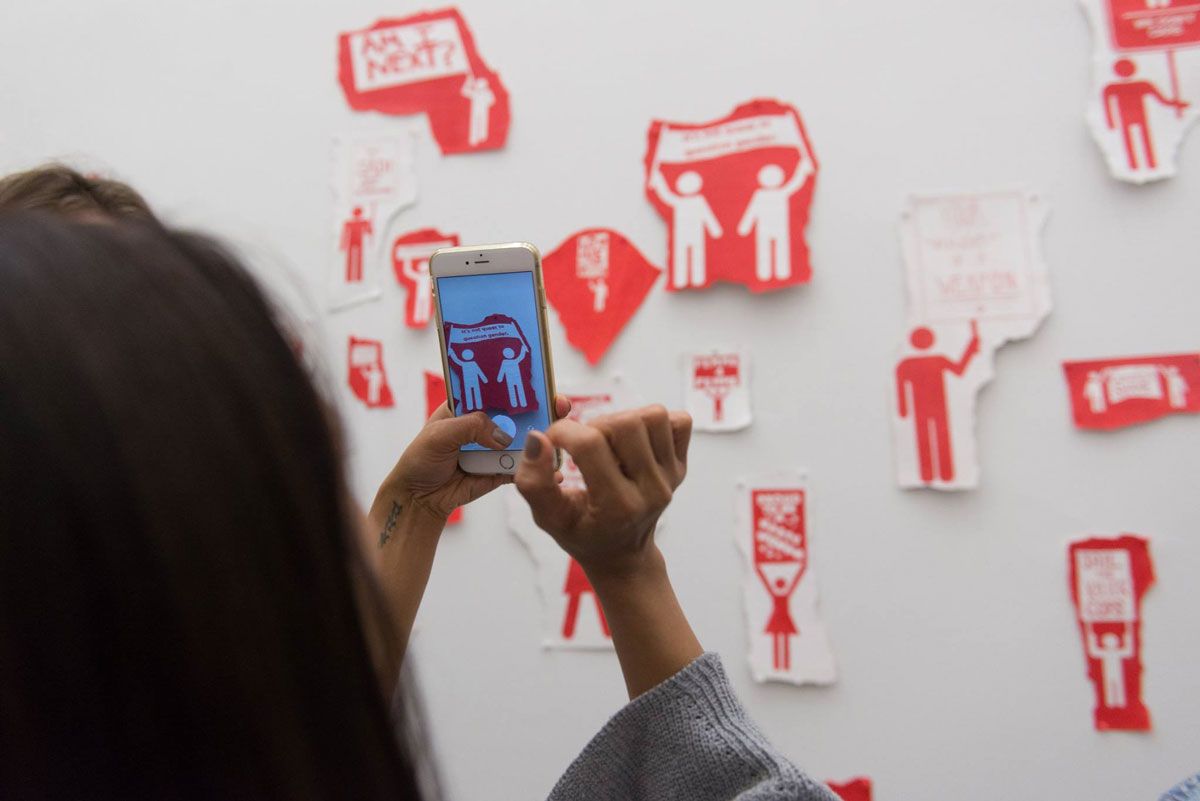 The Power Plant’s fall opening party also served as a launch for the Creative Time Summit. One of the exhibitions on view was Michael Landy’s “Demonstration.” Photo: via Power Plant Facebook page.
The Power Plant’s fall opening party also served as a launch for the Creative Time Summit. One of the exhibitions on view was Michael Landy’s “Demonstration.” Photo: via Power Plant Facebook page.
Kicking off the summit was a party at the Power Plant. The Power Plant first collaborated with the Creative Time Summit in 2015 when they participated in the 56th Venice Biennale—All the World’s Futures. This year, the Power Plant used its seasonal opening party as an opening party to the summit.
Here, people who attend the Power Plant regularly and didn’t know about the summit would learn about it, and vice versa. The weather was just nice enough that you could stand outside with a drink and socialize with summit attendees before the event began the next day, and when it became too chilly you could head inside and do a lap of Amalia Pica’s “ears to speak of,” or Michael Landy’s “Demonstration.”
The next two days showcased presentations and workshops by artists and activists from around the world—or more specifically, artists who are activists and activists who make art (the theme of the summit being Of Homelands & Revolution). Going into the event, I expected something of a day-long academic lecture. This couldn’t have been further from what I experienced.
Instead of a lecture series, I was enthralled by engaging speakers, video projects and musical acts. Speakers, which included Kent Monkman, Wanda Nanibush, Srećko Horvat and Gayatri Chakravorty Spivak as the keynote, were articulate and sincere. I dreaded having to leave my seat for fear of missing one of the concise 10-minute speeches each artist/activist delivered.
During his talk, Kent Monkman shed light on the process of his touring exhibition “Shame & Prejudice: A Story of Resilience.” Slides included the Baroque works that inspired the paintings and the reference material made by staging photographs of Indigenous people in various tableaux.
On his painting The Scream, Monkman noted: “This painting is probably the most important painting in the exhibition and possibly the most important painting I’ve made so far in my career because it tells the story of the removal of children, which is really central to understanding the effects of colonization in our communities.”
Another hit presenter was Victor “Crack” Rodriguez, a performance artist from El Salvador. Using a megaphone, Rodriguez interacted with the audience in a speech cum performance piece. A translator live-translated his words into English, presenting a haunting effect of an echo. Rodriguez ended his performance by teaching the audience how to fall off a chair: gripping the front of an old wooden school desk, tuck your head down (there is a potential for brain damage, Rodriguez noted), push back.
During Saturday’s workshops, held at the AGO, Rodriguez and other presenters could be found mingling with participants, providing a heightened level of interaction. The various workshops, partitioned into three sections, made it so that you could only attend three of the 32 workshops offered. This was a problem only because I wanted to attend them all. On a whole, the workshops with smaller numbers of participants and interactive qualities were the most effective.
Of note was the workshop “In Our Own Words: Revisiting the Black Lexicon Through Poetry,” which was led by poet Phillip Dwight Morgan and involved Black poets from Toronto reading and having a roundtable discussion on the meaning of the poems.
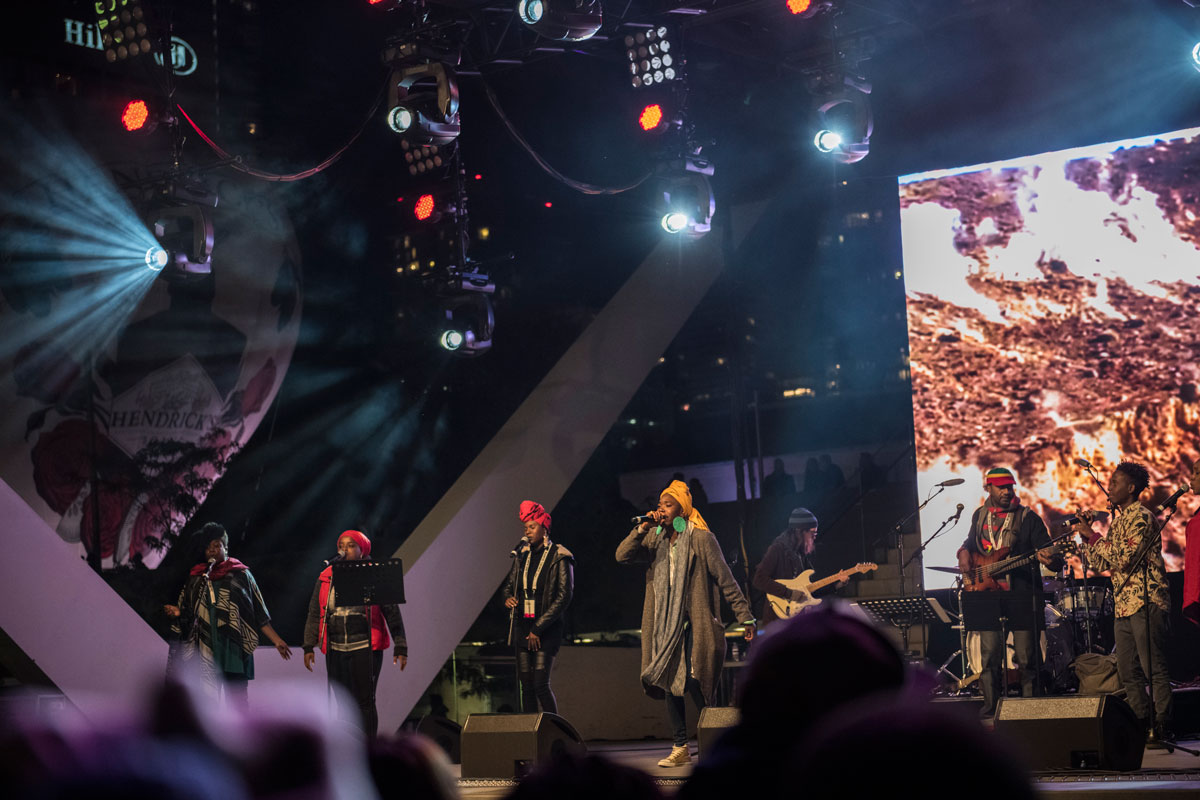 The Nathan Phillips Square soundstage was an all-night venue for Lukumi Dub Opera: 150 Years Before & After, a project by d’bi.young anitafrika and the Watah Theatre. Photo: Courtesy Nuit Blanche.
The Nathan Phillips Square soundstage was an all-night venue for Lukumi Dub Opera: 150 Years Before & After, a project by d’bi.young anitafrika and the Watah Theatre. Photo: Courtesy Nuit Blanche.
Finally, the magnum opus: Thompson’s installation Monument to the Century of Revolutions at Nuit Blanche on Saturday evening. Twenty-one projects from a variety of artists and collectives resulted in a community of revolution packaged into a couple dozen boxcars and one soundstage.
Syrus Marcus Ware and Melisse Watson’s project The Stolen People acted as an underground alliance in a post-apocalyptic world where performers stayed in character the whole time, passing out propaganda pamphlets and necessitating that the viewer engaged with the work in a way that they catch on to and become implicated in the piece, as opposed to getting an explanation of the artists’ ethos outright.
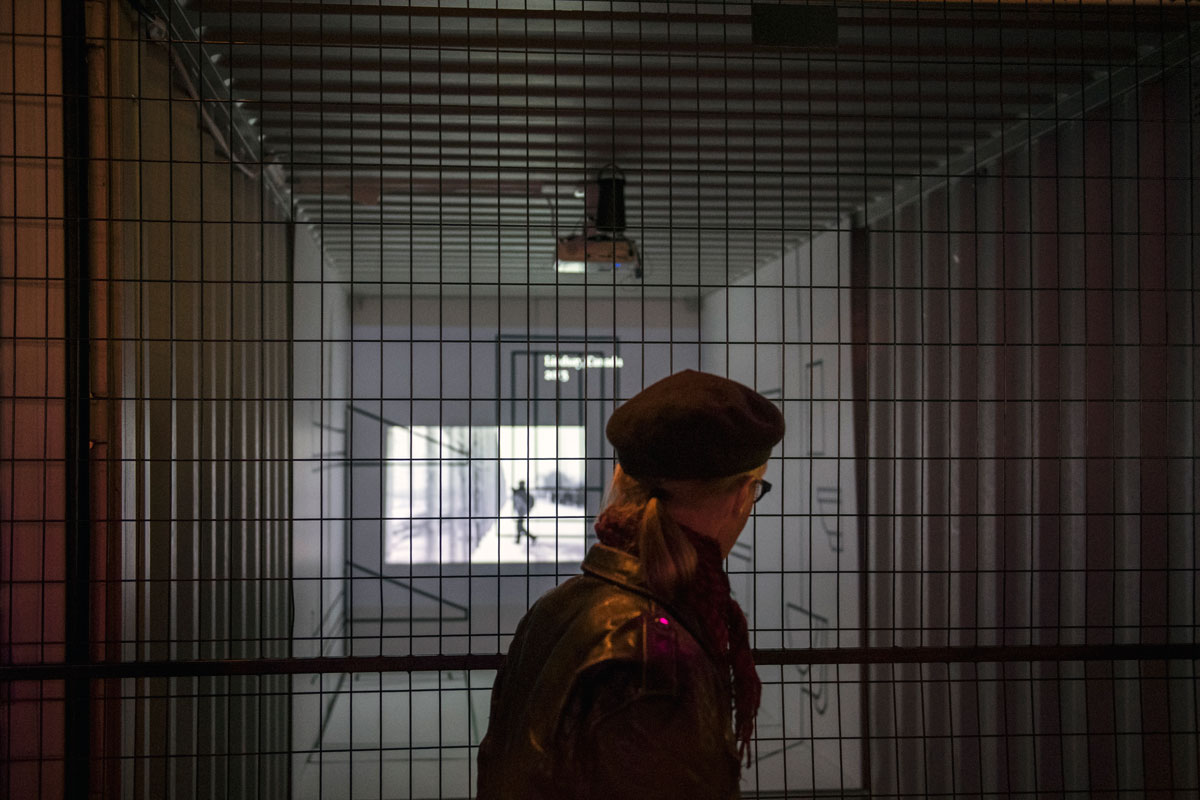 A view of Monument to (Im)mobilization by Tings Chak. Installed in a shipping container at Nathan Phillips Square, it was part of Monument to a Century of Revolutions. Photo: Courtesy Nuit Blanche.
A view of Monument to (Im)mobilization by Tings Chak. Installed in a shipping container at Nathan Phillips Square, it was part of Monument to a Century of Revolutions. Photo: Courtesy Nuit Blanche.
The first thing I noticed about Monument to the Century of Revolutions, however, were the lineups. The shipping containers were surrounded on each side by barricades and security officers letting a limited amount of people in at a time. This was a necessary evil, since the amount of people who attended the event was astronomical, demonstrating the popularity that Nuit Blanche maintains even after a somewhat sullied reputation.
When I first got to the event at 8 p.m., there were easily 500 to 1,000 people in line waiting to experience the exhibit. Here is where I have to admit that I used my press credentials to skip the line—I’m not sure if I would have had the patience to wait in such a long queue.
The prevailing attitude towards the event in past years—one that I’ve shared—is that it became more of a party stop than an art event. Teens could use the guise of the event to persuade their parents to let them stay out all night—I know, I was once a teenager in Toronto—and proceed to partake in a night of partying.
I didn’t encounter the partying that Nuit Blanche became known for at Monument to the Century of Revolutions. For one, I don’t think the installations would have been much fun under the influence. The work was more critical than flashy, making the viewer actively work to interact with the installations rather than passively viewing aesthetically pleasing art.
Another deterrent may have been the line or the early time I attended. Yet being able to attend the event without the distraction of party-goers allowed the work to remain at the centre.
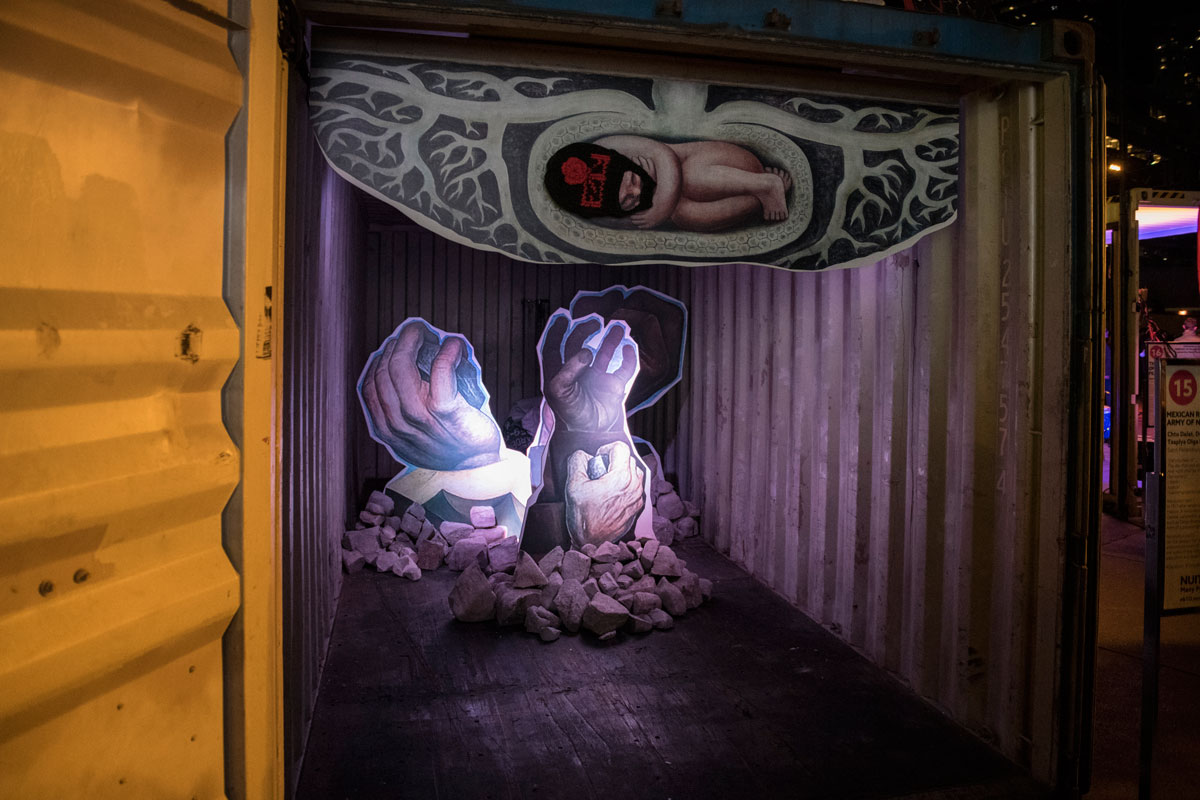 A view of the installation Mexican Revolution 1917 Zapatistas Army of National Liberation Uprizing 1994 at the wider project Monument to the Century of Revolutions at Nathan Phillips Square during Nuit Blanche 2017. This particular project was by Dmitry Vilensky, Tsaplya Olga Egorova and Nikolay Oleynikov. Photo: Courtesy Nuit Blanche.
A view of the installation Mexican Revolution 1917 Zapatistas Army of National Liberation Uprizing 1994 at the wider project Monument to the Century of Revolutions at Nathan Phillips Square during Nuit Blanche 2017. This particular project was by Dmitry Vilensky, Tsaplya Olga Egorova and Nikolay Oleynikov. Photo: Courtesy Nuit Blanche.
Perhaps, for me, the greatest strength of container format was the ability to talk one-on-one with creators. I left the event knowing more than when I had gone in about various revolutions and activist movements.
A high point of the night was sitting down to write a letter to a woman incarcerated for sex work in America as part of The Viminal Space. This shipping-container project, organized by Operation Snatch, explored “the social and legal framing of sex workers as victims and criminals simultaneously: victims if they do not agree to be criminalized and criminals if they don’t agree to be victimized.”
The hands-on act of writing a letter to show solidarity stayed with me long after the night ended. This experience, for me, shows the shift away from an aesthetic-forward Nuit Blanche to an event shrouded in activism.
Speaking with Thompson on the phone the day after Nuit Blanche, he summed up Monument’s purpose this way: “People think this project is about a history of revolutions, but then you see all these groups working, and you realize that all these things that happened in history are happening right now in your city, right then and there. And it’s not that far away. I felt that in some ways you could feel that; art doesn’t just know things, but also feels things. It was a living, breathing world that is Toronto: bumping! Hip hop and radicalism and sex workers and fights against poverty. It’s not just a project that says ‘What if?’ It says, ‘What is?’”
Before Thompson got off the phone, he added: “These are all people in society really pushed to the margins, and this project brought them to the centre. And it felt good to produce a community of people that are put to the margins at the centre.”
By the end of that night, Creative Time and its artistic director had presented what I saw as an alternative to Nuit Blanches of the past—one based not only in the aesthetics of art, but in interacting with the political climate of the world we live in.
Tatum Dooley is a writer living in Toronto.
This story was corrected on October 5, 2017. The original may have implied to some readers that Creative Time had been commissioned, as an organization, to curate a section of Nuit Blanche. In fact, it was only Creative Time’s artistic director, Nato Thompson, who was commissioned by the City of Toronto to curate it.

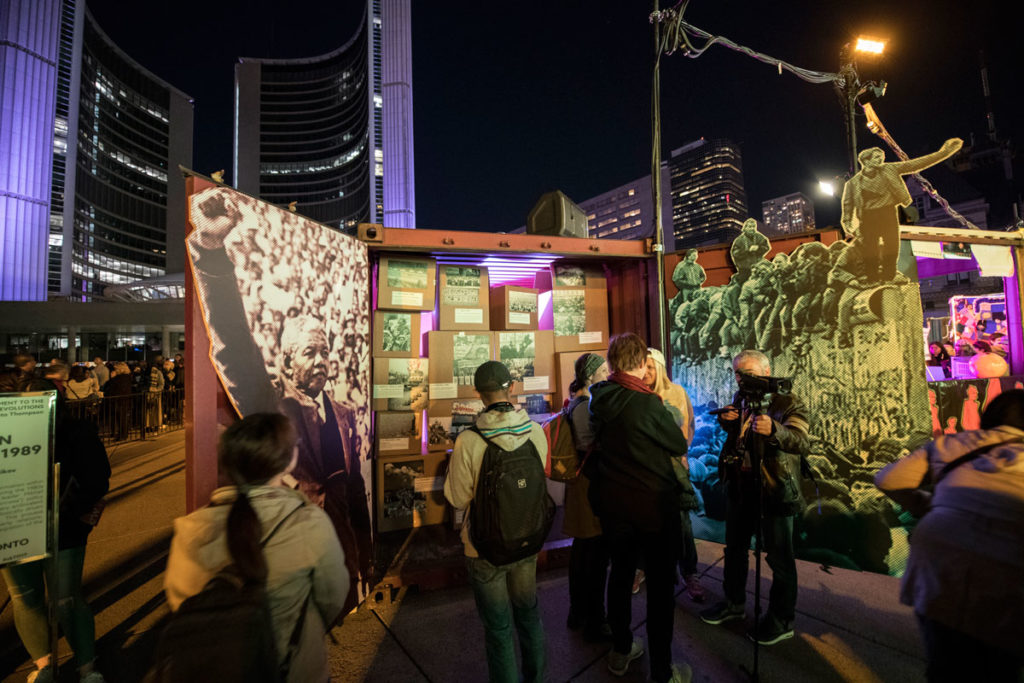 A view of Colour Revolutions by Dmitry Vilensky, Tsaplya Egorova and Nikolay Oleynikov at Nathan Phillips Square during Nuit Blanche and Monument to a Century of Revolutions. Photo: Courtesy Nuit Blanche.
A view of Colour Revolutions by Dmitry Vilensky, Tsaplya Egorova and Nikolay Oleynikov at Nathan Phillips Square during Nuit Blanche and Monument to a Century of Revolutions. Photo: Courtesy Nuit Blanche.
